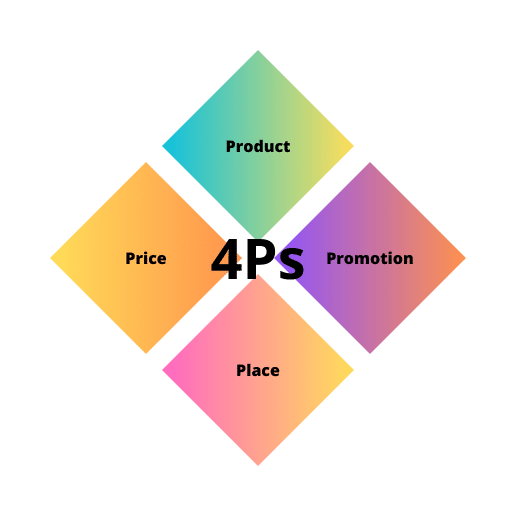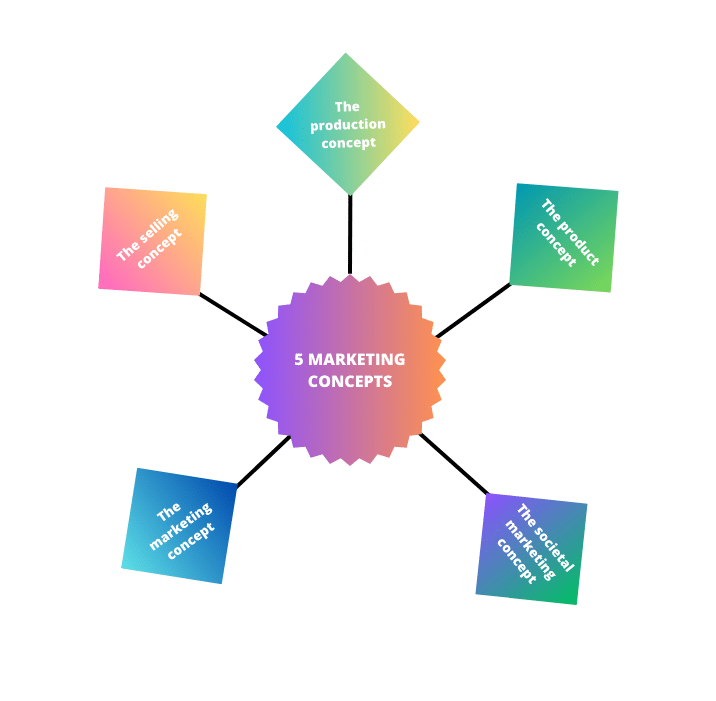Have you ever tried to describe what marketing is and then struggled to give a concrete answer?
Don’t worry, you’re not alone.
Marketing covers a vast range of activities and disciplines, making it a challenge to define. In this blog, we will cover some marketing basics and explain how to apply a few tactics.
- What is Marketing?
- What’s the Main Purpose of Marketing?
- What Are the Four Ps of Marketing?
- More Theories of Marketing: What Are Marketing Concepts?
- What Are the Main Types of Marketing?
- Four Ways to Boost Your Business With Marketing
- Build a Marketing Strategy and Watch Your Business Grow
What is Marketing?
The American Marketing Association defines it as:
“The activity, set of institutions, and processes for creating, communicating, delivering, and exchanging offerings that have value for customers, clients, partners, and society at large.”
Which, to be honest, we find a little fluffy.
HubSpot defines marketing as:
“Any actions a company takes to attract an audience to the company’s product or services through high-quality messaging. [It] aims to deliver standalone value for prospects and consumers through content, with the long-term goal of demonstrating product value, strengthening brand loyalty, and ultimately increasing sales.”
This definition is better, but we feel it misses some key points. We believe marketing is much more.
Marketing is a dynamic and expansive realm that encompasses everything from deeply understanding your audience to honing the captivating tone of your copy, crafting irresistible content to connect with the right people and beyond.
It is not just about the act of selling something, but about why you’re selling it. It’s human psychology at its best, knowing why people buy and what motivates them to spend money with you.
In this article, we want to set out in more detail what marketing is and discuss marketing basics including the principles and theories that define it.
What’s the Main Purpose of Marketing?
Much like the definition of marketing, defining its purpose can be a challenge. But ultimately, marketing is about growth. That’s why it’s important to have a strategy in place and plan how it will be implemented.
Much has been written about it over the years, with several theories and concepts put forward to try and give some structure to the discipline. Below, we’ll address some of these marketing basics to show how modern marketers approach building a marketing strategy.
What Are the Four Ps of Marketing?
The roots of modern marketing can be traced back to 1964 when Neil Borden, from Harvard Business School, wrote about the 12-component marketing mix.
Neil attempted to define the main tasks undertaken by those working in a marketing capacity. At the time, marketing was still in its infancy, and most theories concerned manufacturing physical products.
Over time, the 12-component mix was refined and eventually, the four Ps of marketing emerged. This is certainly something you should know as part of some marketing basics:
- Product
- Price
- Place
- Promotion

Product
We often use the phrase “products and services” when discussing what a company sells. In marketing, when we speak about a product, we use it as a term to cover all items, tangible and intangible.
A good marketer will know about every aspect of their product. They will have spent time studying the market, speaking with customers to understand their challenges, and then they will have had a hand in developing a product that serves that customer group.
Once a product is created, your job as a marketer is to introduce it to your customers in a way that appeals to them. You’ll know how to promote that product and what benefits and features to concentrate on to attract interest from qualified leads ready to buy.
Price
Once you have a product that you know appeals to your chosen market, you have to decide on a price that depends on how much the market is willing to pay.
This is not a straightforward calculation; as a marketer, you’ll need to know your customer group, what they value most, and how much they earn if you should offer a discount (and how much).
Every aspect of pricing can affect whether a product is successful or not.
Place
How will you sell your product? Online or in brick-and-mortar stores? Does it need to be displayed in a particular way or shelved in a specific section of the store?
Where will the product be advertised? Magazines? Online only or a mix of both?
This P is about how your product is placed (literally and figuratively) in the market and how that then affects how the product is viewed by potential customers.
Promotion
The final piece in the puzzle, this P, concentrates on how you will promote your product. Marketing covers such a wide range of activities that the avenues for promotion are almost endless.
From print advertising to online ads, special offers, discounts, and sales, what you choose to do is dependent on your product and your customer group.
Which social media platform will you use? Will you blog? Will you use email marketing? These activities fall under promotion and form part of any marketing strategy.
More Theories of Marketing: What Are Marketing Concepts?
Marketing concepts is a collective term describing several approaches or concepts that can underpin the promotion or development of a product or service. They are underpinning philosophies of marketing that inform how one might approach promoting a business, product, or service. This is an important part of marketing basics.
Five concepts underpin marketing:

- The Production Concept revolves around mass marketing, assuming that customers seek easily accessible and affordable products. It emphasizes the notion of catering to consumer demand for readily available and cost-effective offerings.
- The Product Concept states that a customer focuses primarily on a product’s quality, features, and benefits.
- The Selling Concept is the concept of “hard sell.” It assumes your customer won’t buy from you unless you push them into it.
- The Marketing Concept focuses on what your customer needs and asks what their biggest problem is. Figure that out, then develop a product to solve their issue.
- The Societal Marketing Concept builds on the previous concept, and it says you should focus on your customers’ needs and make sure your solution is ethical and does not harm.
These concepts together form the basis of modern marketing, and it’s worth considering and understanding all of them, even if your main focus is on just one of the concepts.
What Are the Main Types of Marketing?
So, we talked about the theories of marketing, but what about the actual practical day-to-day practice? What does marketing for a business look like daily? This is a significant topic and too much to cover here, but for now, we’ll touch on a summary.
Marketing activities can be split into two areas under which all other activities fall. These are:
Inbound Marketing
Inbound marketing is the process of building and deepening your relationship with your existing customers. This can include:
- SEO – Search engine optimization or the process of optimizing your website to rank as highly as possible in Google search
- Content marketing – Any content you produce, whether it’s on your social media or your website, counts as marketing.
- Social media – Tied with content marketing, word of mouth is a powerful way to market your product.
Outbound Marketing
Outbound marketing is the process of finding new customers. It can take several forms, including print and TV advertising, flyers, billboards, face-to-face meetings, sales calls, and sponsorship deals.
Four Ways to Boost Your Business With Marketing
If you’re just starting out promoting your business or product, there are some things that you should be doing from the start of your journey to marketing what matters for your business.
1- Understand Your Customers and Your Products – Social Media
Before anything, you need to know who your ideal customer is and what problems your product solves for them.
You can do this in a number of ways, but the simplest is through your social media platforms. Build relationships with your customers, ask them questions, run competitions, answer their concerns and respond to their queries and comments.
Social media is not fast, but consistency will eventually pay off by helping you to build a loyal and long-term customer base.
2- Build an Email List and Write a Newsletter
Building an email list does not have to be complicated. Several email marketing services offer free accounts for those just starting out.
Email marketing is well worth exploring, it’s relatively cheap, and the evidence shows a good email marketing campaign is worth its weight in gold.
You’ll often hear marketers talk about there being gold in the list (email list). The secret to a successful long-term business is cultivating a long-lasting, respectful relationship with your existing customers. Email is a reliable way to do this.
3- Invest in SEO and Local SEO
Another long-term strategy that will pay dividends is if you invest in it early. Make sure your website is optimized for keywords you want to rank for, and make sure your Google My Business is completed.
This is particularly important if your primary business driver is customers who are geographically close to you. SEO is crucial if you want a long-term strategy that will become self-sustaining down the line.
4- Start a Blog
Content is king when it comes to promoting your business and products. Good content helps you to build trust, gain authority in your niche, and establish yourself as the go-to person or company to speak to in your chosen field.
Build a Marketing Strategy and Watch Your Business Grow
This has been a quick overview of marketing basics; however, there is much more to cover. If you’re looking to put together a marketing strategy or need advice on planning your marketing, let Rock Content help you.
Our Marketing Planning Bundle 2023 gives you access to 3 clusters of marketing and sales resources to guide you through:
- Result Analysis and Goal Settings
- Creating an Action Plan
- Execution and Improvements
We can also help you with one of the most important tactics that must compose your digital marketing strategy: content creation.
WriterAccess by Rock Content is the ideal platform to help you streamline your content production, combining the efficiency of AI-powered tools with the creativity of human writers.
Why not give it a try today? Enjoy 14 days of free access to our network of expert writers and discover what great content can do for your business!








